Geometry | Chapter 5 | 8th Maths - Similar Triangles | 8th Maths : Chapter 5 : Geometry
Chapter: 8th Maths : Chapter 5 : Geometry
Similar Triangles
Similar
Triangles
Consider
two given triangles PQR and ABC. They are said to be similar (~) if their corresponding
angles are equal and corresponding sides are proportional. That is ∠P = ∠A, ∠Q = ∠B and ∠R = ∠C and also PQ/AB = PR/AC = QR/BC. This
is denoted as ∆PQR ~ ∆ABC .
There are
4 ways by which one can prove that two triangles are similar.
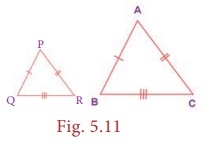
(i) AAA (Angle – Angle
– Angle) or AA (Angle – Angle) Similarity
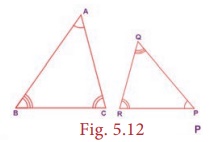
Two triangles
are similar if two angles of one triangle are equal respectively to two angles of
the other triangle. In the given figure, ∠A = ∠P , ∠B = ∠Q .
Therefore, ∆ABC ~ ∆PQR.
(ii) SAS (Side – Angle
– Side) Similarity
Two triangles
are similar if two sides of one triangle are proportional to two sides of the other
triangle and the included angles are equal. In the given figure, AC/PQ = AB/PR and
∠A = ∠P and hence ∆ACB ~ ∆PQR.
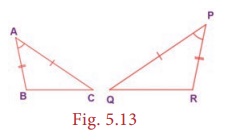
(iii) SSS (Side-Side-Side)
Similarity
Two triangles
are similar if their corresponding sides are in the same ratio. That is, if AB/PQ
= AC/PR = BC/QR , then ∆ABC ~ ∆PQR.
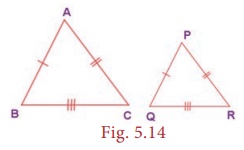
(iv) RHS (Right Angle –
Hypotenuse – Side) Similarity
Two right
triangles are similar if the hypotenuse and a leg of one triangle are respectively
proportional to the hypotenuse and a leg of the other triangle. That is, if ∠B =
∠Q = 90º and AC/PR = BC/QR then, ∆ABC ~ ∆PQR.
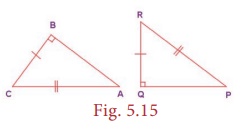
If ∆ABC ~ ∆PQR, then the corresponding
sides to AB, BC and AC of ∆ABC are PQ, QR and PR respectively and the corresponding
angles to A, B and C are P, Q and R respectively. Naming a triangle has a significance.
For example, if ∆ABC ~ ∆PQR then, ∆BAC is not similar to ∆PQR.
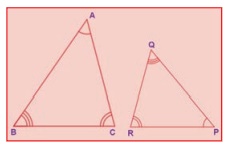
Example 5.5
In the Fig.
5.16, if ∆PQR ~ ∆XYZ , find a and b.
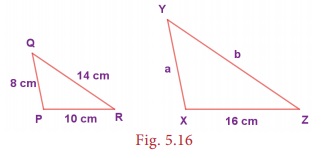
Solution:
Given that
∆PQR
~ ∆XYZ
Their corresponding
sides are proportional.
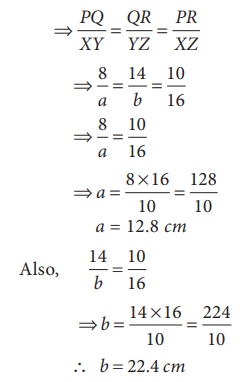
∴
b = 22.4 cm
Note
• All circles and squares are similar to each other.
• Not all rectangles need to be similar always.
• If two angles are both congruent and supplementary then, they are
right angles.
• All congruent triangles are similar.
• The symbol ~ is used to denote similarity.
Example 5.6 (Illustrating AA Similarity)
In the Fig. 5.17 , ∠ABC ≡
∠EDC and the perimeter of ∆CDE is 27 units, prove that AB ≡
EC.
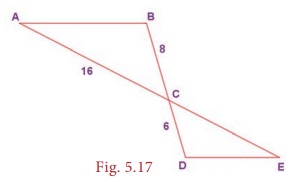
Proof:
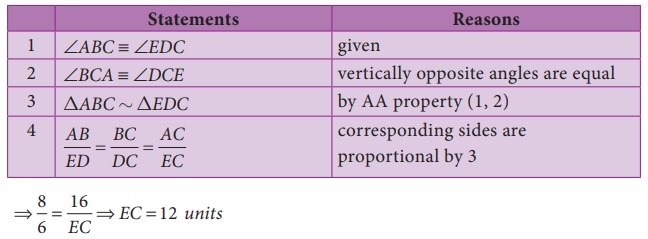
⇒ 8/6
= 16/EC
⇒
EC =12 units
Given, the
perimeter of ∆CDE = 27 units,
ED + DC + EC = 27
⇒
ED + 6 + 12 = 27
⇒
ED = 27–18 = 9 units

AB/9 = 8/6 ⇒ AB = 12 units and hence AB = EC.
Example 5.7 (Illustrating AA Similarity)
In the given
Fig. 5.18, if ∠1 ≡ ∠3 and ∠2 ≡ ∠4
then, prove that ∆BIG ~ ∆FAT . Also find FA.
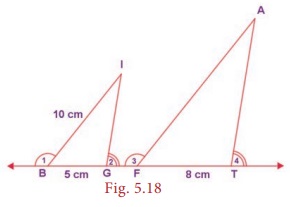
Proof:
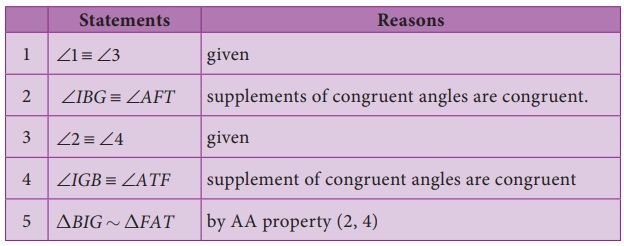
Also, their
corresponding sides are proportional
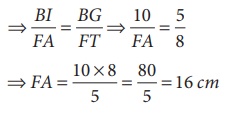
Example 5.8 (Illustrating SAS Similarity)
If A is the
midpoint of RU and T is the midpoint of
RN, prove that ∆RAT ~ ∆RUN .
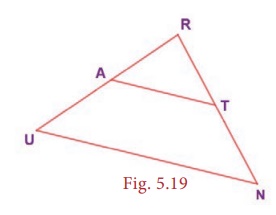
Proof:
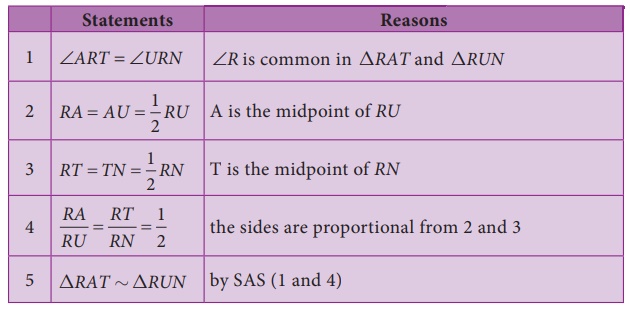
Example 5.9 (Illustrating SSS similarity)
Prove that
∆PQR
~ ∆PRS in the given Fig. 5.20.
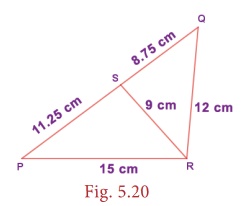
Solution:
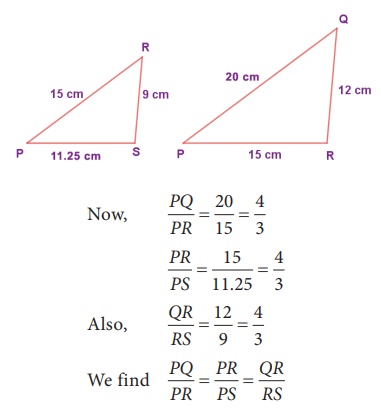
That is,
their corresponding sides are proportional.
By SSS Similarity,
∆PQR
~ ∆PRS
Example 5.10 (Illustrating RHS similarity)
The height of a man and his shadow form a triangle similar to that formed by a
nearby tree and its shadow. What is the
height of the tree?
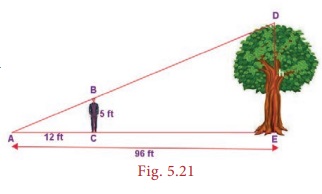
Solution:
Here, ∆ABC
~ ∆ADE (given)
Their corresponding
sides are proportional (by RHS similarity).
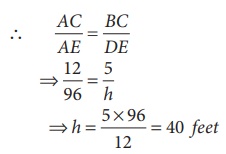
⇒
h = [5×96] / 12 = 40 feet
The height of the tree is 40 feet.
Activity
The teacher cuts many triangles that are similar or congruent from
a card board (or) chart sheet. The students are asked to find which pair of triangles
are similar or congruent based on the measures indicated in the triangles.
Related Topics